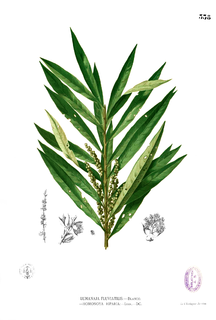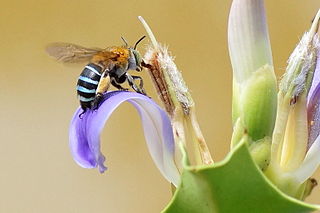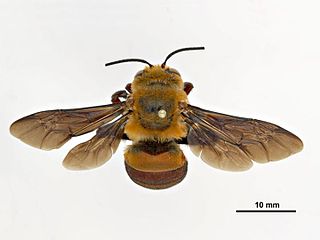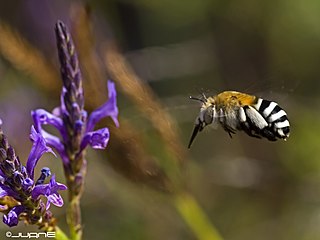
Homonoia is a plant genus of the family Euphorbiaceae first described in 1790. These are rheophytes and usually found in groups at riverbanks in India, southern China, Southeast Asia, and New Guinea.
- Homonoia intermediaHaines - India
- Homonoia retusa Müll.Arg. - India
- Homonoia riparia Lour. - Guangxi, Guizhou, Hainan, Sichuan, Taiwan, Yunnan, Cambodia, India, Assam, Bhutan, Sri Lanka, Borneo, Java, Lesser Sunda Islands, Sulawesi, Sumatra, Maluku, Laos, Malaysia, Myanmar, Philippines, Thailand, Vietnam, New Guinea, Andaman & Nicobar Islands

The Anthophorini are a large tribe in the subfamily Apinae of the family Apidae. Species in this tribe are often referred to as digger bees, although this common name is sometimes also applied to members of the tribe Centridini. It has over 750 species worldwide that were previously classified in the family Anthophoridae; the vast majority of species are in the genera Amegilla and Anthophora.
Panmixia means random mating. A panmictic population is one where all individuals are potential partners. This assumes that there are no mating restrictions, neither genetic nor behavioural, upon the population and that therefore all recombination is possible. The Wahlund effect assumes that the overall population is panmictic.

Amegilla is a large genus of bees in the tribe Anthophorini. Several species have blue metallic bands on the abdomen, and are referred to as "blue-banded bees".

Archeria is a small genus of shrubs in the family Ericaceae. As currently circumscribed the group includes six species, all native to southern Australasia. Four of these are endemic to Tasmania, and the other two endemic to New Zealand.

Amegilla cingulata, commonly known as the blue-banded bee, is an Australian native bee that occurs in many other regions. Currently, several scientific organizations are conducting research on how the blue-banded bee benefits agriculture through its distinctive "buzz pollination". These bees are very important for the production of food and contribute to at least 30% of crops in Australia.

Amegilla bombiformis, commonly known as the teddy bear bee or golden haired mortar bee, is an Australian native bee in the family Apidae.

Amegilla dawsoni, sometimes called the Dawson's burrowing bee is a species of bee that nests by the thousands in arid claypans in Western Australia. It is a long tongued bee, of the tribe Anthophorini and genus Amegilla, the second largest genus in Anthophorini.
Archeria comberi, also known as the pink mountain heath or comb heath, is a small, rare shrub endemic to Tasmania, Australia. As a member of the heath family, Ericaceae, this species is generally classified as a subalpine/ alpine species and shares many characteristics with other members of the family. It is an evergreen shrub 0.15m-1m in height, with pink flowers during the summer months, hence its common name pink mountain heath. Archeria comberi is often found growing among other species such as Nothofagus gunnii and Persoonia gunnii.
Amegilla confusa, is a species of bee belonging to the family Apidae subfamily Apinae.
Amegilla violacea is a species of bee belonging to the family Apidae subfamily Apinae.
Amegilla mucorea, is a species of bee belonging to the family Apidae subfamily Apinae.
Amegilla fallax is a species of bee belonging to the family Apidae subfamily Apinae.
Amegilla subcoerulea is a species of bee belonging to the family Apidae subfamily Apinae.
Amegilla niveocincta, is a species of bee belonging to the family Apidae subfamily Apinae.
Amegilla perasserta, is a species of bee belonging to the family Apidae subfamily Apinae.
Amegilla puttalama, is a species of bee belonging to the family Apidae subfamily Apinae.
Amegilla zonata is a species of blue-banded bees belonging to the family Apidae, widely distributed in SE Asia, where it is often confused with the Australian species Amegilla cingulata.

Amegilla canifrons, the Canary islands Blue-banded bee is a species of bee, belonging to the family Apidae. The species is endemic to Canary Islands.







